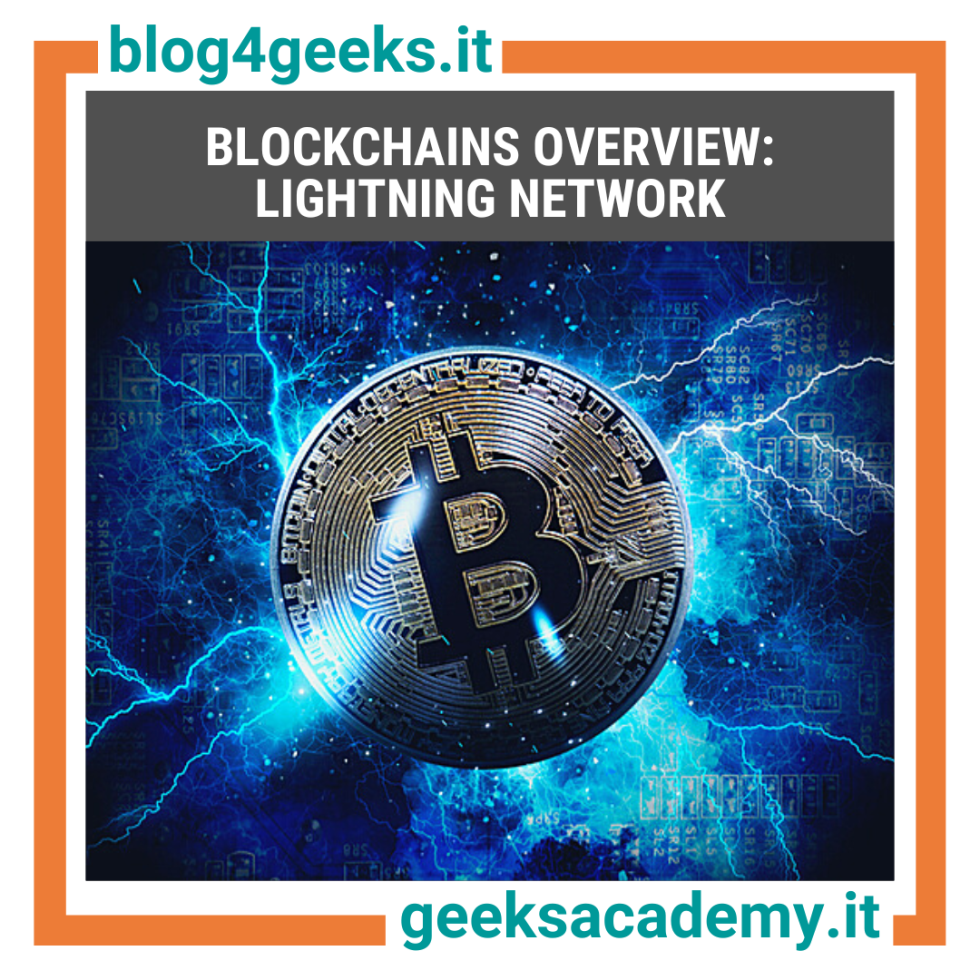
Discover Geeks Academy’s articles on: Blockchain, Coding, Cybersecurity, Cloud, Big Data, Artificial Intelligence, Gaming, Digital Innovation
Lightning Network (LN) is a layer 2 protocol built on top of the Bitcoin blockchain. The purpose of layer 2 is simple: integrating with an underlying layer 1 blockchain to increase transactional throughput (transactions per second, TPS). Layer 2 networks only report back to the main blockchain to finalize the results. If the reason for this practice is intuitive for dApps and smart contracts, why would Bitcoin need it?
Why LN?
Bitcoin suffers an issue that still raises many doubts and debates, scalability. As the number of users increases, the Bitcoin network gets larger (by 2022, it weighs more than 450 GB), leading to a further difficulty: finding high-performance hardware capable of blocks validation. This hindrance affects mass adoption as well as security. In a nutshell, Bitcoin network capacity is represented by the amount of information regarding BTC transfers. So if Marco wants to send 1 BTC to Alice, he will make a transaction and if Alice wants to send BTC to Marco, she should sign a new transaction. Therefore, every time Marco and Alice interact, they open and close a unidirectional communication channel. Lightning Network introduces an innovation: LN uses a bidirectional channel, allowing Marco and Alice to continuously trade BTC regardless of the amount of transactions they make.

How LN works?
To understand why Lightning Network could be the future of scalability, we jump back to Marco and Alice’s case. However, to make things spicier, let’s add a third factor, Carlo. Carlo has already opened a communication channel with Alice, but he has never interacted with Marco. The LN network, through the use of algorithms, is able to get advantage of the channel Marco and Alice have been using so far and let Carlo communicate with Marco. Along with the increased network capacity (now made of three balances, Marco’s, Alice’s and Carlo's BTCs), LN will calculate the shortest and most suitable path to exchange BTC. As with communications, the direct route may not necessarily be the fastest or the least expensive. Aggregation makes things easier, allowing Lightning Network to carry out transactions as long as the channels between users are open. Marco and Alice will be able to access the bidirectional channel through a confirmation called "signature" via a multisig address. Within this channel, Marco and Alice provide a sum of BTC they want to exchange until one of them closes the connection. Both Marco and Alice will have to validate the transaction. Once done, it will be registered on the LN. The capacity of the Lightning Network is thus expressed as the amount that Marco and Alice provide on the channel. The advantage is to carry out multiple transactions that do not alter the state of the layer-1 blockchain (Bitcoin) and therefore are not registered until the channel is closed. Despite the potential multiple operations, what will result after closing the communication is just a single unique transaction, which certifies the respective BTC balance left to Marco and Alice.
The future of Lightning Network
One of the main risks surrounding LN is centralization. In fact, a node that “gets acquainted” with many users will have much more ease in acting as an intermediary, bringing some sort of centralized communication. In 2021, the LN network jumped from the capacity of 1000BTC to 3000BTC in just eight months, also thanks to El Salvador’s Chivo wallet and Cash App led by Jack Dorsey (former Twitter CEO). In addition, a recent report by Arcane Research estimated LN to reach 700 million users by 2030.

Why you should learn blockchain?
DeFi, Agrifood, IoT, Sharing Economy, Insurance, Art, Gaming, Law. Blockchain’s use cases are endless, and understanding the way to make this technology even more efficient is just the beginning. One of the most relevant field of application is the industrial sector, where countless jobs of the future could theoretically be replaced by smart contracts, oracles and AI.
Blockchain’s skills are increasingly in demand. It is not too late to start your career now: blockchain is just becoming everyday life. However, the learning curve is still steep: many companies still cannot fully understand the difference between an usual database and a blockchain, so when they turn to business advisors, their use cases are often not suitable for the technology they want to use.
Here’s what it takes:
By checking different job vacancies, this is a list of the most relevant skills and requirements:
- Understanding of algorithms, data security, decentralized technologies and data structures.
- A solid background in coding skills, with at least one of the following programming languages: Python, JavaScript, JAVA, C, C++.
- General understanding of ledgers, blockchains and cryptocurrencies.
- Expertise in performance management and anomaly detection.
- At least basic experience in building blockchain frameworks and business applications.
Don't live the future as a sidekick... be a superhero! Discover Geeks Academy’s training offer in Blockchain & Coding:
Blockchains Overview is an in-depth series about the most popular blockchains. Below a comprehensive list of the ones we have been talking about:
Sources:
https://cointelegraph.com/news/bitcoin-lightning-network-growth-capacity-plateaus-at-3-400-btc
https://lightning.network/
https://en.wikipedia.org/wiki/Lightning_Network